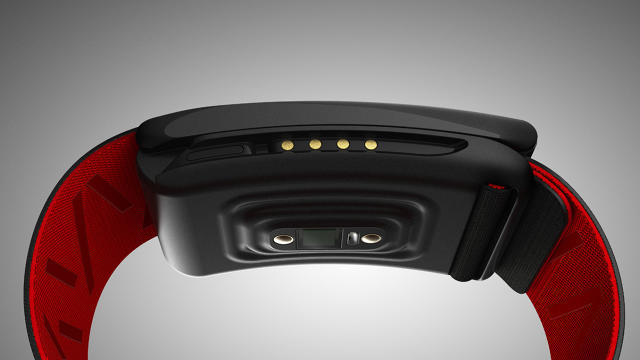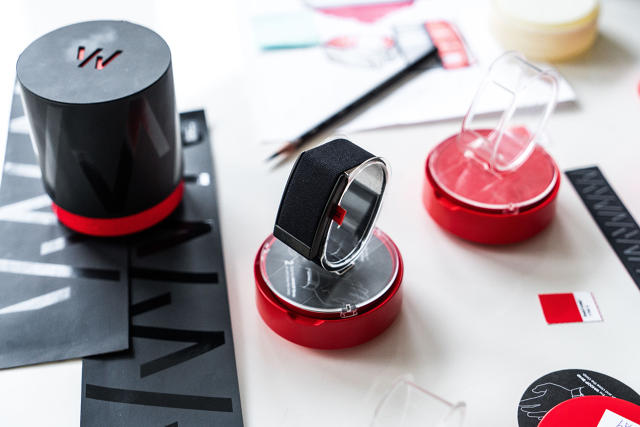Designing a wearable for elite athletes like LeBron James is no small feat. The Cleveland Cavaliers forward needs the ability to precisely measure his performance on and off the court, share that data with his coaches and trainers, and visualize it to make sense of everything—all at an extreme level of detail that would be overkill for regular users. That requires a wearable he can wear literally 24/7—one that's lighter, more accurate, and fits better than any other wearable on the market.
So James doesn't wear an Apple Watch, a Nike FuelBand, or a Fitbit. He wears a Whoop, a wearable aimed at helping athletes track their progress as well as predict their future performance. This so-called "performance enhancement system" designed and marketed for elite athletes has some serious design cred behind it, including MIT Media Lab's Nicholas Negroponte, data viz maestro Martin Oberhaüser, and Rinat Aruh and Johan Liden of the boutique studio Aruliden.
Together, they've created a wearable for the sporting gods, not us flabby norms. But to do so, they had to solve some of wearables' biggest design problems: It had to not look like tech masquerading as fashion, and it had to be something you could wear all day, every day, without recharging.

The Tech
Whoop doesn't really look like a piece of tech. Mostly, it's a breathable knit fabric band, attached by aluminum clasps to a Chiclet-sized gadget that can measure an athlete's heart rate, accelerometry, skin conductivity, and temperature up to 100 times per second. With that data, Whoop can determine not just the usual things such as step count and calories burned, but how much an athlete has strained himself during a session, and how he'll perform the next day.
How does it do that? "Heart rate variability is the key to understanding your central nervous system, which consists of what are called sympathetic and parasympathetic responses," says Whoop founder Will Ahmed, a former squash player at Harvard turned Boston-based entrepreneur. If you have good heart rate variability, every sympathetic response will be followed by a parasympathetic response, which tells the Whoop band if an athlete is functioning at 100%. If heart rate variability is out of alignment, though, you can tell that he or she needs time to rest, and won't perform as well in a match or game until they do so.
Heart rate variability is something that's usually only measured in athletes by an EKG, not a wearable. But Whoop manages to do so thanks to a combination of sophisticated on-board sensors and the fact that it's always sampling, because you never have to take it off to charge it.

The Industrial Design
When Negroponte, an early investor and advisor in Whoop, introduced Ahmed to Rinat Aruh and Johan Liden of the New York product design firm Aruliden, they realized that they were up for a challenge. Because Whoop is supposed to be worn constantly, they needed to design a wearable that elite athletes wouldn't just not have to take off, but wouldn't want to take off.
"From the beginning, we realized that it was important this product exude precision, power, and performance," says Liden. "At the same time, though, we realized that athletes are people, too. They don't want to walk around all day wearing something that looks like a heart monitor. They want to feel like they're wearing a device that blends into their life."
The first problem to solve for was battery life. Although the interval can be anywhere from a few hours if you're wearing an Apple Watch to a few weeks if you're wearing a Fitbit, wearables still need to be taken off periodically and plugged in to stay functional. That was a nonstarter for a gadget that needed 24/7 access like the Whoop, Liden says, but the alternatives were ridiculous. "What were we going to do, make these athletes lay in bed all night with a power cable snaking up to their wrist?" he asked.
The solution Aruliden came up with is "almost like a parasite," Liden says. It's a small, lightweight battery pack that snaps onto the Whoop when it needs to be charged, and snapped off again and plugged into the wall when not needed. It's like the wearables equivalent of the USB battery pack you keep in your bag.
Another important part of the Whoop was fit. To collect the data it needs, the Whoop has to press snugly up against the skin. Athletes wrists, however, vary dramatically in size, not just between men and women, but between sports. By using a proprietary, sweat-resistant fabric strap with a polyurethane outer, Aruliden was able to achieve a good fit without adding unnecessary weight or bulk to the design. And since the strap is only half a millimeter thick, there's little chance that it will catch on something during a game the way a watch might.

Visualizing The Data
The most important part of the Whoop is the data it collects. To sell this to sports teams and leagues, Whoop needed to be able to visualize the data so athletes and coaches could use it to make intelligent training decisions.
Whoop approached Martin Oberhaüser, a German-born information and interface designer who has done work for Pepsi, Audi, BMW, and Airbnb.
"I knew Martin was one of the best information designers in the world, because that's what I Googled to find him," laughs Ahmed, who flew out to Germany on a lark to convince a reluctant Oberhaüser to join his team in 2012 when Whoop was just a bunch of wired components in a cardboard box. Once Ahmed explained to him how Whoop wasn't just a high-end step counter, Oberhaüser grew interested.
"One of the things that really intrigued me is the challenge of not just visualizing this massive amount of health data, but learning about it myself," Oberhaüser says. "A metric like heart rate variability is a fascinating look inside the central nervous system, but you need to understand it before you can frame it for someone else."
So Oberhaüser built a software dashboard, which exists on both smartphones and the web. It measures a lot of the same things that many fitness trackers do, such as calories burned and heart rate, but it breaks down athlete performance into three simple metrics: strain (or how hard you've been working out), recovery (how hard you should be working out), and sleep (how well you slept). Each of these metrics is coded to a circle, which changes color from green to yellow to red as you move away from your target zone. All of these metrics can be drilled into for more details, but they are also viewable in aggregate on a team dashboard, allowing coaches to see at a glance which of their players need a rest, and which need to be pushed harder that session.

Will Whoop Ever Be For Norms?
This sort of overview of an entire team's health is why Whoop, a product most people have never heard of, is being courted so hard by professional sports leagues. Ahmed says he can't tell me exactly which teams are using Whoop, but he says that the wearable is currently being used across the NFL, NBA, NHL, Major League Baseball, as well as by teams in all major conferences at the collegiate level. Whoop says LeBron James wears one, and they sent us a pic, as well as Michael Phelps, the American competition swimmer who has won a total of 22 different medals.
Us norms, though? We can't buy one . . . at least, not yet. In fact, Ahmed is being coy about whether or not the Whoop will ever be available for consumers. But it's hard not to look at some of the design innovations his design team came up with, such as the "parasitic" battery charger, and not hope they make their way to consumer wearables in some form or another. Why should pro athletes be the only ones to get a truly wearable wearable?
[App photo: Al Bello/Getty Images]